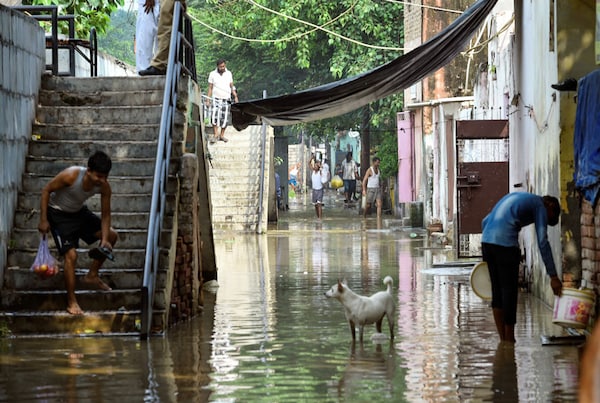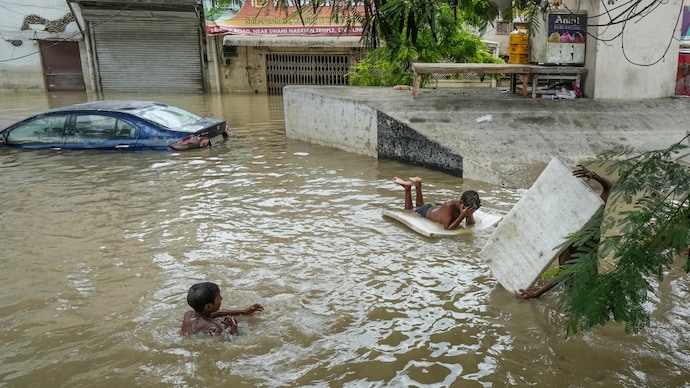Powerful Weather Warning as IMD Issues Yellow Alert for Delhi-NCR; Yamuna River Above Danger Mark, 48 Hours of Intense Weather Ahead

Powerful Weather Warning as IMD Issues Yellow Alert for Delhi-NCR; Yamuna River Above Danger Mark, 48 Hours of Intense Weather Ahead
The India Meteorological Department (IMD) has issued a strong weather warning for the National Capital Region (NCR) due to continuous heavy rains. With the Yamuna River crossing the danger mark, authorities are on high alert, urging residents to be cautious and vigilant. The yellow alert signals the possibility of heavy rainfall and potential waterlogging, posing significant risks to life and property.

As the city of Delhi and its surrounding areas brace themselves for the upcoming challenge, the IMD predicts heavy to very heavy rainfall in the next 48 hours, which may worsen the current situation and lead to widespread disruptions.
The monsoon season is in full swing, and the region has already experienced several intense rainfall episodes. The rising water level of the Yamuna River raises concerns about possible flooding in low-lying areas along its banks.
Officials from the Delhi Disaster Management Authority (DDMA) and other agencies are closely monitoring the situation. Precautionary measures are being put in place to lessen the impact of the expected heavy rainfall. Authorities are setting up relief camps and emergency response teams in case of any untoward incidents.

The IMD’s yellow alert serves as a warning for residents to be prepared for adverse weather conditions. It advises people to stay indoors whenever possible and avoid venturing into flooded areas or crossing overflowing streams and water bodies.
Due to its dense population and infrastructure, Delhi is particularly vulnerable to the effects of heavy rainfall. Apart from waterlogging and flooding, the city’s clogged drainage systems may exacerbate the situation during the downpour.

Public transportation services could be severely affected, leading to traffic congestion and delays. Authorities recommend using public transport only when necessary and avoiding driving through waterlogged streets to prevent vehicle breakdowns and accidents.
The heavy rainfall also raises concerns about waterborne diseases spreading in such conditions. Stagnant water creates breeding grounds for mosquitoes, increasing the risk of diseases like dengue and malaria. Health officials have issued advisories to take necessary precautions and maintain hygiene during this period.
Residents are advised to store enough essential items, including food, water, and medicines, in case regular supply chains are disrupted. They are also encouraged to keep emergency contact numbers at hand and ensure their mobile devices are charged.
Local authorities are conducting awareness campaigns to educate people about the precautions they need to take during such weather events. Community-driven initiatives are playing a vital role in ensuring that vulnerable sections of society, such as the elderly and those with disabilities, receive timely assistance and support.
The monsoon is crucial for agriculture and water reservoirs, but excessive rainfall can also lead to soil erosion and landslides in hilly areas. Authorities are urging residents living in vulnerable regions to be cautious and take necessary precautions to avoid any mishaps.
In response to the imminent weather challenges, local authorities have activated their disaster response mechanisms to provide swift assistance in emergencies. Search and rescue teams are on standby, equipped with necessary tools to aid individuals stranded in flood-affected areas. Evacuation plans have been prepared for regions at high risk of flooding, ensuring the prompt and safe relocation of residents to designated shelters.
Extreme weather events can have long-term effects on the environment and infrastructure. Heavy rains and subsequent flooding may damage roads, bridges, and buildings, resulting in substantial repair costs for the government and private property owners. Furthermore, the risk of water contamination due to overflowing sewage systems poses a critical health hazard that demands immediate attention. Addressing these challenges requires a multi-faceted approach, including investments in resilient infrastructure and effective urban planning to cope with future weather extremes.
The yellow alert serves as a wake-up call for policymakers and citizens to prioritize climate change adaptation and mitigation strategies. The increasing frequency and intensity of extreme weather events underscore the urgency of transitioning to sustainable practices that reduce greenhouse gas emissions and minimize environmental degradation. Additionally, promoting eco-friendly habits at the individual level, such as conserving water and reducing waste, can collectively make a significant difference in building a more climate-resilient society.
As the region prepares for the impending heavy rainfall, cooperation and solidarity among citizens, communities, and authorities will be crucial in effectively managing the situation. Staying informed about weather updates and advisories from the authorities is essential. By being prepared and following safety guidelines, we can significantly reduce the risks associated with the monsoon season. Heeding the warnings, implementing preventive measures, and fostering a climate-conscious mindset can empower Delhi-NCR to become a more resilient and adaptive urban center in the face of future weather challenges.





